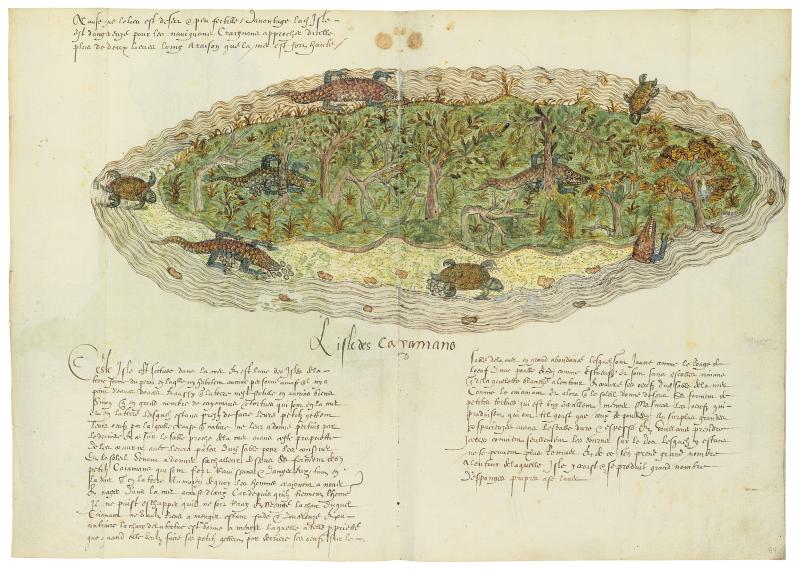
Histoire Naturelle des Indes
Illustrated manuscript
Bequest of Clara S. Peck, 1983
Continued from fol. 93
Since the place is deserted and almost infertile, it is besides dangerous for the navigators who are afraid to approach closer than two leagues on account of the sea being very high.
Lisle Des Cayamans (Cayman Island)
This island is located in the ocean and is one of the islands of the mainland of Peru on which nobody lives because there is no fresh water and also because the soil does not produce any goods except a great number of caymans and turtles which live in the sea as well as on land. When these [the caymans] are ready to have little ones, they throw out their eggs through their mouth because nature did not provide an opening in their behind and this occurs on the sand close to the sea. They have the habit of covering the eggs with sand with their paws in order to protect them and when the sun warms them, little caymans are formed which are ravenous and dangerous in the sea as well as on land so that people are afraid to swim in the sea because of them. For when they hold a man, he cannot escape being carried off and eaten. The meat of the cayman is not valued as food, being dull and flavorless. On the other hand, the meat of the turtle is good eating. It has the habit when it wants to have little ones of throwing out the eggs in great abundance through its behind on the sand. They are yellow like the yolk of a hen's egg, round like a tennis-ball and without a shell, having only a white jelly all around it. They cover the eggs with sand like the cayman and when the sun shines on them, little turtles are formed which are excellent food. Even the eggs they produce have as much taste as those of a hen and are, besides, big and capacious, having a hard and thick shell. If one wants to take these, it is advisable to turn the turtle on its back. Being unable to move, one can take a great number. All around the island grow and are produced a great number of sponges good for washing oneself.
In 1983, The Morgan Library & Museum received, as the bequest of Clara S. Peck, an extraordinary volume whose beautiful paintings and descriptions document the plant, animal, and human life of the Caribbean late in the sixteenth century. Spaniards had already begun to exert influence over the indigenous people of the area when explorers from England and France arrived, among them Sir Francis Drake. The volume, known as the Drake Manuscript and titled Histoire Naturelle des Indes when it was bound in the eighteenth century, gives us a wonderful picture of daily life at the time of Drake's many visits to the region. Although Drake's connection to the manuscript is uncertain, he is mentioned on more than one occasion by the authors. Drake himself is known to have painted, but none of his work survives.
Contents: 199 images of West Indian plants, animals and human life, with accompanying manuscript captions written in late sixteenth-century French.
Medium: Most of the illustrations consist of a black chalk underdrawing and a combination of pen and brown ink with watercolor; on some images selected areas have also been glazed with a gum.
Binding: Bound or rebound in brown leather in the late 18th century.
Pagination: Penciled folio numbers (1–125) in lower right corner of each page were added by The Morgan Library & Museum. Folios 92v–93, 93v–94, and 95v–96 are fold-out leaves.
